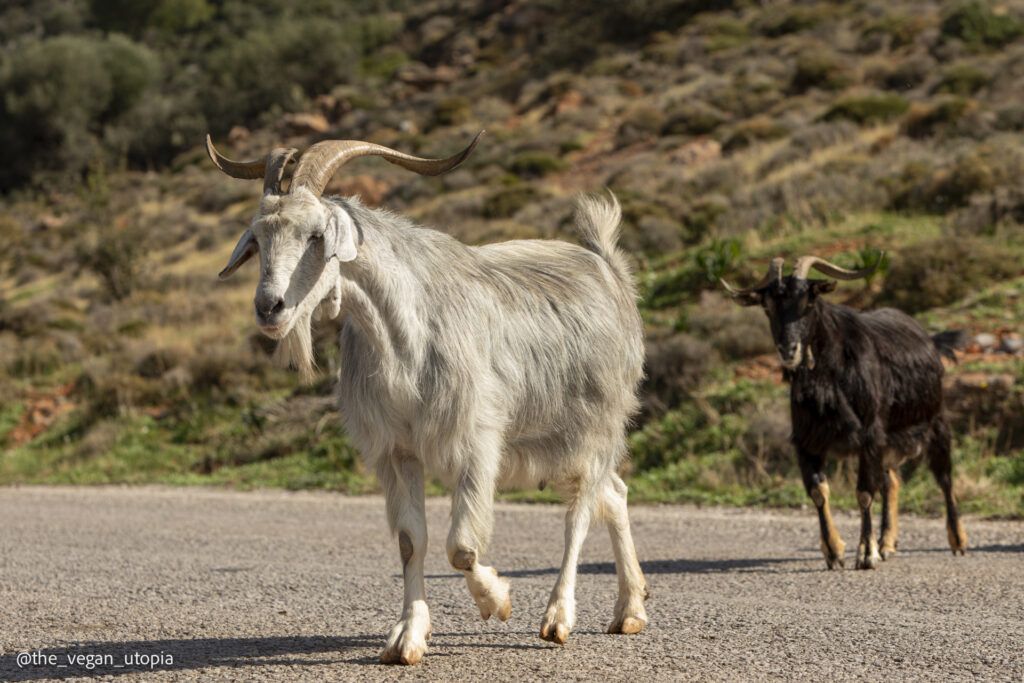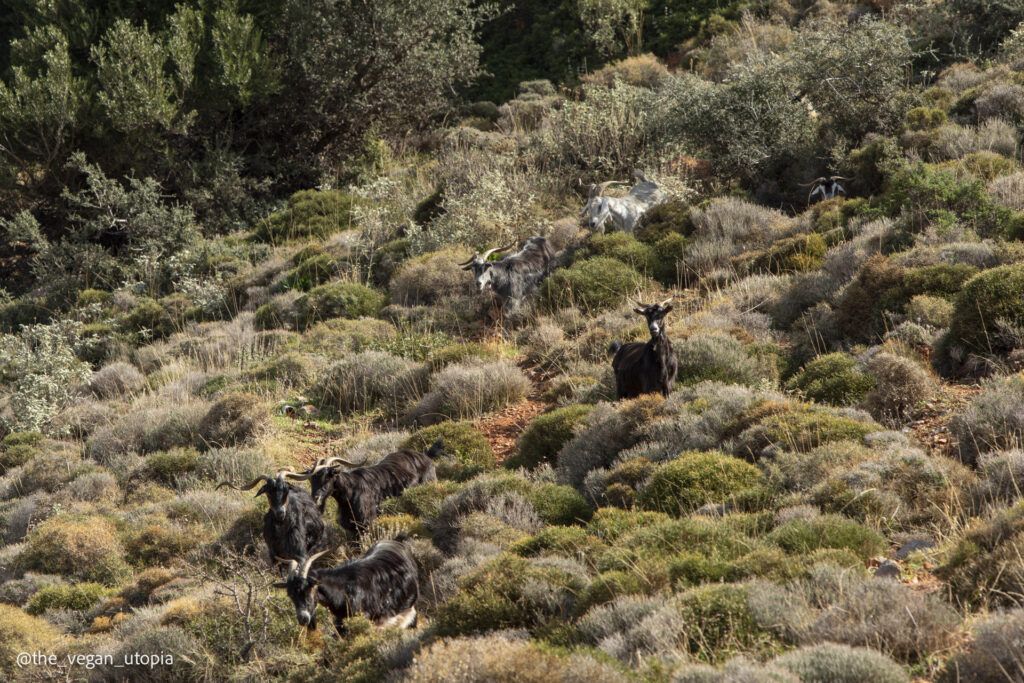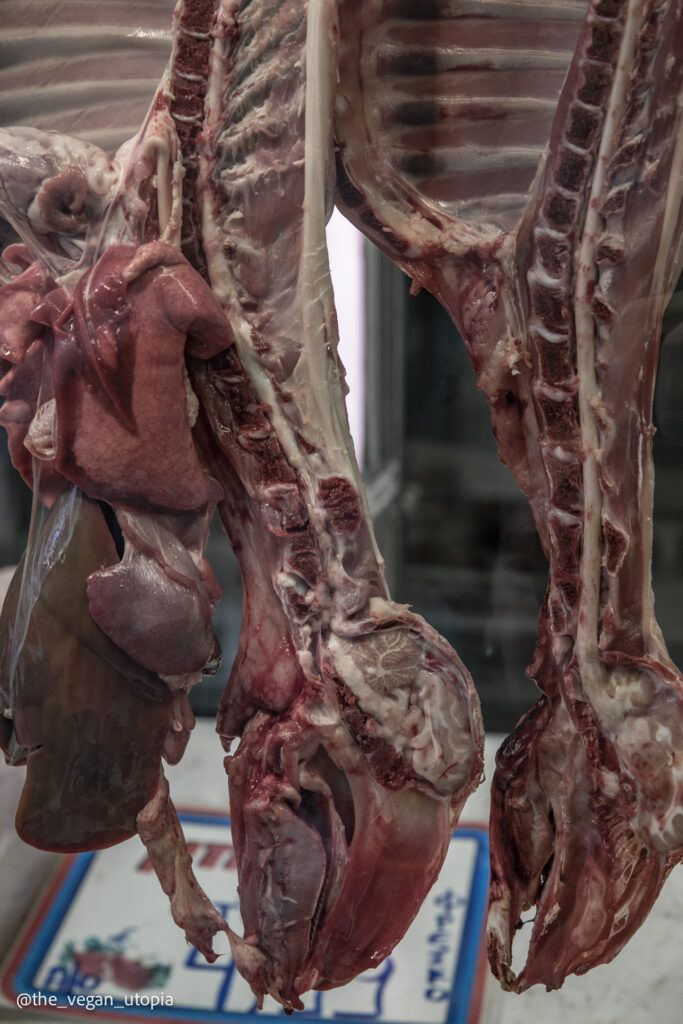The look we cast upon them
- January 21, 2022
While driving through a valley in Greece I had to stop and wait a few minutes. A long line of goats, and lambs crossed the road. The most curious thing is that I didn’t see any shepherd leading them. It was a group of at least 30 animals, maybe 50, apparently led by a white goat that looked a little more graduated, setting the direction of the traffic behind him. They came from hills with low vegetation and as they crossed the road they entered a fenced-in ranch. I wondered why these animals traded the freedom of the mountain for the confines of the ranch, apparently of their own free will. Would they be aware of their destiny and still choose it? Or were they ignorant of the cost of that human protection against natural weather? This cost is based on the exploitation of their bodies, to a greater or lesser extent according to their sex, and the termination of their lives when it is profitable for their owners. Their lives as well as all their offspring. This reasoning thus elaborated, I soon realized, probably doesn’t happen in the mind of a goat. The ability to understand the world beyond its immediate surroundings and to plan the future based on this understanding, avoiding his own death, stands out as one of the differences between humans and other sentient animals. But what is sentience anyway? And do animals have an interest in preserving their own lives or are they indifferent to death? Let’s try to answer these two questions before going back to the Greek goats.

In short, sentience is an ability we share with most animals, excluding only those that do not have a central nervous system, such as mussels. This ability allows us to feel pleasure and pain, but also fear and joy, anger and compassion. The degree of presence of these emotions in animals can be difficult to determine, although our intuition indicates that yes, a cat that does not receive attention can feel sadness and a dog that awaits the return of its owner is able to feel and express anxiety and, with his or her arrival, joy. We understand that these animals with whom we share a home not only need food and shelter to live, they also have subjective needs. However, not every cat and dog will react in the same way to the same stimulus, and this indicates the presence of personality in these animals. They are individuals, and as such, they will have particular likes and dislikes.


Goats crosssing a road in Greece, 2021. ©Vitor Schietti
Even when exposed to the above facts, the mere recognition of animal sentience does not seem to be enough to advocate (and practice) the end of animal exploitation. Some will go as far as declaring they practice “flexitarianism”, a term that is some sort of greenwasher version of its less cool synonym, “carnism”, or even decide to adopt ovo-lacto vegetarianism, yet another definition for the same carnism. When it comes down to facts, neither flexitarianism or the variations of vegetarianism are doing much for the animals. Many will defend “responsible consumption” and a “humanized treatment of animals”. Advocating for such “responsible” exploitation are entities such as “Compassion in world farming“, whose mission is, according to them, to improve the quality of life of livestock animals. At first it is tempting to join a line of thought that seeks better living conditions for animals, but the effect that some of them produce ends up being the opposite, depending on the agenda of these institutions. What they often do is to further regulate and expand the forms of animal exploitation, increasing their distance from the right to life and not being property. Even worse, organisms such as RSPCA “have allowed cruel practices to be inflicted on animals while simultaneously alleviating the concerns of consumers about those practices“, as Ed Winters demonstrates in a series of investigations on this and other regulatory organs and entities (Winters, 2022, 54).
But would it be possible to be absolutely sure that animals care about the continuity of their lives, assuming that they have enjoyed some degree of freedom, like the Greek goats crossing the road? I looked for answers in one of the most acclaimed books on the debate between abolitionist and welfarist currents: “The Animal Rights Debate, abolition or regulation?”, by Gary L. Francione and Robert Garner. In a free translation I incorporate the following excerpts.

Sheep living in an animal sanctuary in Spain, 2021. ©Vitor Schietti
“There are two distinct ways in which harm might be caused by death. The first, what DeGrazia (2002, 59–61) calls the “desire-based account,” postulates that death causes harm because it denies a desire to stay alive. DeGrazia is probably right to assert here that no animals, except perhaps the higher mammals, even understand the concept of staying alive, let alone the desire to do so. As a result, death is not a harm for animals according to this account of the harm caused by death.Normal adult humans, on the other hand, clearly do possess the concept of death, and most do have a desire to stay alive.

DeGrazia (2002, 61) also identifies an “opportunities-based” account of the harm caused by death. Unlike the desire-based account, this view does not depend on an individual’s awareness of the opportunities lost by death. Rather, “death is an instrumental harm in so far as it forecloses the valuable opportunities that continued life would afford. It is important to recognize that great anxiety is likely to be caused by a fear of death, a feeling that will not be present in a being that has no conception of his or her own future. But assuming the death was instantaneous and unexpected, it is the lost opportunities that are thwarted. In other words, there are harms of deprivation. So, it is wrong to claim that painless death causes no harm because we are not aware of it. We can clearly be harmed even though we are unaware of the fact.
For a person, death means that a future is taken away, consisting of a constellation of experiences, beliefs, desires, goals, projects, activities, and various other things” (Rowlands 2002, 76). If the life is taken of a being who does not have this “constellation of experiences” or has them to a lesser degree, it is difficult to see that this being can be harmed to the same extent, provided the death is painless. (…) This suggests that human lives are of greater moral importance than animal lives. (…) this is not to say that they lose nothing by death. (Francione & Garner, 2010, 117).
Therefore, even if we consider human life more valuable than non-human animal life, death for both implies a loss, a deprivation of opportunities. Continuing a bit more, we come to sentience once again:
“Sentience is not a characteristic that has evolved to serve as an end in itself. Rather, it is a trait that allows the beings who have it to identify situations that are harmful and that threaten survival. Sentience is a means to the end of continued existence. Sentient beings, by virtue of their being sentient, have an interest in remaining alive; that is, they prefer, want, or desire to remain alive. Therefore, to say that a sentient being is not harmed by death denies that the being has the very interest that sentience serves to perpetuate. It would be analogous to saying that a being with eyes does not have an interest in continuing to see or is not harmed by being made blind.” (Francione & Garner, p.116)
Regarding blinding an animal to serve human interests, it is worth remembering the common practice of eye ablation in crustaceans, which consists of removing the eyes of female shrimp so that they reproduce faster, as a result of a hormonal imbalance thus caused. Crustaceans, as well as octopuses, fish and other marine animals have recently been recognized as sentient beings, but the treatment to which they are subjected is far from this formal recognition.
Before seeking empathy for shrimp, however, it is easier to feel it for mammals, since we are also, it is always worth remembering, mammalian animals. And so we return our look to the Greek goats that graze on barren hills, but whose bodies are exploited for their milk and slaughtered for their meat.
Shrimps cooked in milk-based sauce. ©Rogerio Schietti


Greece is the country with the largest number of goats in Europe, and the overpopulation of the animal is a problem for the Greek flora as a result of overgrazing that prevents forest growth and causes erosion. On the island of Samothraki the population of goats has exploded, with up to 15 animals of the species for every human on the island. The government’s response in an attempt to restore the ecosystem is to encourage the consumption of this animal’s meat and the secretions of their bodies (a.k.a. goat cheese), a practice that only supplies and encourages a market that will not reduce once fewer goats roam the Greek hills. Declaring war on goats generates violence, and what can we expect from violence? The subjection of animals as consumer goods and all the violence required for that is the very cause of the imbalance in Greece and elsewhere. Only its rupture can offer a possibility of resolution on new grounds that are more inclusive and less greedy.
Goat cheese for sale in a supermarket in Barcelona, Spain, 2021. ©Vitor Schietti
When vegan movements advocate an end to the torture and murder of animals, it is important to bear in mind precisely these two claims. They are not saying that an animal that has lived in semi-freedom, well treated, whose basic needs and perhaps even some emotional and cognitive needs have been met, can be killed because it will have already fulfilled its role.
It is not enough to stop the torture of the big industry (while pretending animals bred in “local farms” have a much better treatment, which is another misconception). We ought to recognize the very act of killing as incompatible with human and animalistic values. The question is then to understand how much these values are part of the society we want to build.
This is the mother of all crises, because it determines how we see and treat everything and everyone else that is not ourselves. The look we cast on non-human animals is the same look that discriminates against or welcomes other humans. But this idea is widely confronted with the belief that “we must first deal with human rights, only later animal rights”, which was a phrase I heard by a passerby who quickly dismissed the animalist demonstration in which I participated in the center of Barcelona, in January of this year. He couldn’t have been more wrong, but he couldn’t have been more closed to the debate either, since he had already concluded it before any discussion or investigation. He certainly wasn’t considering the human being themselves exploited by the industry that leads above any other in cases of depression, anxiety, suicide and other social dysfunctions (Winters, 2022, 54).

Vitor Schietti in a street action by Barcelona Animal Save
Civil rights movements have obvious intersections with the animal cause. In the words of Angela Davis, a vegan, penitentiary abolitionist, and diverse civil rights activist, “we have to engage in an exercise of intersectionality, always foregrounding these connections. to remind people that nothing happens in isolation.” Veganism is intersectional in that it recognizes, promotes, and also supports other libertarian causes. However, few, if any other cause will be as present, and at the same time as invisible, as humanity’s crisis with non-humans, which is reinforced several times daily in the act of eating.
Undoubtedly there is an enormous difficulty in instituting the values of veganism in societies globally and reversing all the suffering and death inflicted on non-human animals within a generation. However, flying a heavier-than-air machine, communicating instantly with anyone anywhere on the planet, and abolishing human slavery (at least institutionally, acknowledging that slavery never completely ceased to exist) seemed unattainable challenges in their time, dismissed as impossible and as utopian or not even imagined. Human experience before these feats followed other laws, was subject to other limitations. The status quo always exerts its pressure and, for many, there was no point even debating something that radically broke the current reality. Fortunately, these discredited people were wrong, but only because others maintained the discourse and actions necessary to change the current reality.
But just like dogs and cats, not all humans will have the same sensitivity to facts that expose the suffering of others, nor will they care in equal measure about individuals who are not themselves or their closest surroundings. Empathy beyond whom we know most closely requires effort, all the more so to include other species. Cognitive dissonance is a powerful hurdle to overcome, and you may not even be willing to acknowledge it. However, if the images of the lacerated bodies of animals that didn’t want (nor needed) to be killed were able to inflict some discomfort on you, maybe it’s time to recognize what this look reveals, and no longer look away.


A cat and a goat, residents of two different animal Sanctuaries in Spain, Asociación Defensa de los Équidos and Almas Veganas. ©Vitor Schietti

2 thoughts on “The look we cast upon them”
You choose peace or war?
Where there is a will, there is a way.
Comments are closed.